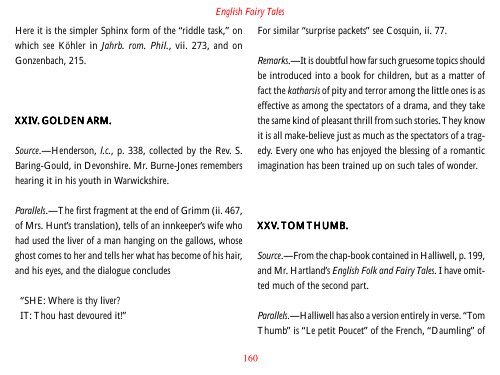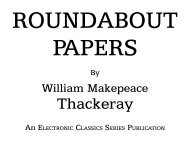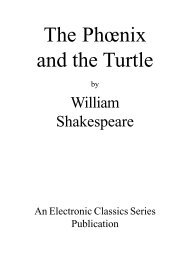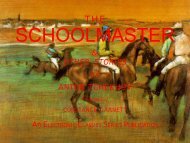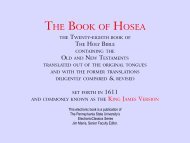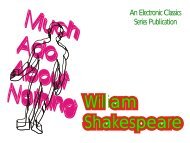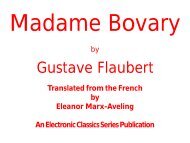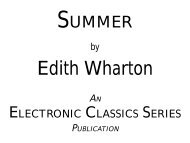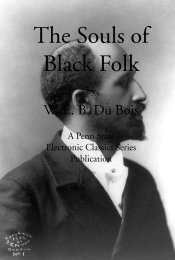- Page 1 and 2:
ENGLISHFAIRY TALESCOLLECTED BYJOSEP
- Page 3 and 4:
ContentsPreface....................
- Page 5 and 6:
ENGLISHFAIRY TALESCOLLECTED BYJOSEP
- Page 7 and 8:
Joseph Jacobsglish, and it is a mer
- Page 9 and 10:
Joseph JacobsTOMTIT TOT“I’ll ha
- Page 11 and 12:
Joseph Jacobs“Well,” says she,
- Page 13 and 14:
Joseph JacobsWell, when the girl he
- Page 15 and 16:
Joseph Jacobscame to a woman’s co
- Page 17 and 18:
Joseph Jacobsthe loss. She said to
- Page 19 and 20:
Joseph JacobsIn ran father and son,
- Page 21 and 22:
Joseph Jacobsfire; the fire began t
- Page 23 and 24:
Joseph Jacobs“I started to go ups
- Page 25 and 26:
Joseph Jacobsthe boys followed him
- Page 27 and 28:
Joseph Jacobstakes up the vegetable
- Page 29 and 30:
Joseph Jacobsdead asleep upon a ben
- Page 31 and 32:
Joseph Jacobshe went off as fast as
- Page 33 and 34:
Joseph Jacobshair were pearls and p
- Page 35 and 36:
Joseph JacobsThe faster you’d eat
- Page 37 and 38:
Joseph JacobsNext day they said to
- Page 39 and 40:
Joseph JacobsTEENY-TINYawakened by
- Page 41 and 42:
Joseph JacobsBack goes Jack home, a
- Page 43 and 44:
Joseph Jacobspassing the ogre he to
- Page 45 and 46:
Joseph JacobsJack ran as fast as he
- Page 47 and 48:
Joseph JacobsWell, he huffed, and h
- Page 49 and 50:
Joseph JacobsOne day the master was
- Page 51 and 52:
Joseph Jacobsweeps, and so I hop;
- Page 53 and 54:
Joseph Jacobsfor you to go, and God
- Page 55 and 56:
Joseph JacobsThe gentleman now make
- Page 57 and 58:
Joseph Jacobshim in his other waist
- Page 59 and 60:
Joseph Jacobsgoing on with what the
- Page 61 and 62:
Joseph Jacobsabout the little porri
- Page 63 and 64:
Joseph Jacobsthe little old Woman j
- Page 65 and 66:
Joseph Jacobsfountain and fell fast
- Page 67 and 68:
Joseph Jacobssuch great numbers tha
- Page 69 and 70:
Joseph Jacobsbrought it under his i
- Page 71 and 72:
Joseph JacobsThen, coming to the mi
- Page 73 and 74:
Joseph JacobsHENNY-P-PENNYSo they w
- Page 75 and 76:
Joseph Jacobshim, he called out to
- Page 77 and 78:
Joseph Jacobsshe said the spell tha
- Page 79 and 80:
Joseph JacobsThe hall was furnished
- Page 81 and 82:
Joseph JacobsWho have you there wif
- Page 83 and 84:
Joseph JacobsBut Molly never said a
- Page 85 and 86:
Joseph Jacobsbut it was not a good
- Page 87 and 88:
Joseph Jacobs“Snouk but and snouk
- Page 89 and 90:
Joseph JacobsTHE HISTORORY Y OF TOM
- Page 91 and 92:
Joseph Jacobsone mouthful. While th
- Page 93 and 94:
Joseph Jacobsbut at last poor Tom f
- Page 95 and 96:
Joseph Jacobsging a beautiful young
- Page 97 and 98:
Joseph JacobsLAZY JACKCKold woman;
- Page 99 and 100:
Joseph JacobsJOHNNY-CAKEOn went Joh
- Page 101 and 102:
Joseph JacobsEARL MAR’S DAUGHTERa
- Page 103 and 104:
Joseph Jacobsflew till they swooped
- Page 105 and 106:
Joseph JacobsWhen he got him there,
- Page 107 and 108:
Joseph Jacobsyou will like a sousin
- Page 109 and 110: Joseph Jacobsbe a man! Well, I will
- Page 111 and 112: Joseph Jacobspresent that the king
- Page 113 and 114: Joseph JacobsTHE STRANGE VISITORORt
- Page 115 and 116: Joseph JacobsTHE LAIDLAIDLY WORMfor
- Page 117 and 118: Joseph JacobsAs the ship came near,
- Page 119 and 120: Joseph Jacobscow may give me milk,
- Page 121 and 122: Joseph Jacobsafter having been brou
- Page 123 and 124: Joseph JacobsTHE MAGPGPIE’S NESTO
- Page 125 and 126: Joseph Jacobsto eat, so watched the
- Page 127 and 128: Joseph Jacobsfound Kate and the you
- Page 129 and 130: Joseph JacobsTHE ASS, THE TABLE, AN
- Page 131 and 132: Joseph Jacobswith it to the inn, an
- Page 133 and 134: Joseph Jacobsof fire, and off they
- Page 135 and 136: Joseph Jacobstom of the sieve with
- Page 137 and 138: Joseph JacobsMASTER OF ALL MASTERS
- Page 139 and 140: Joseph Jacobsever they require, tha
- Page 141 and 142: Joseph Jacobswho she was.“I am,
- Page 143 and 144: Joseph JacobsII. THE THREE SILLIES.
- Page 145 and 146: Joseph JacobsVI. MR. VINEGAR.VII. N
- Page 147 and 148: Joseph JacobsXI. CAP O’ RUSHES.XI
- Page 149 and 150: Joseph JacobsXVI. TATTY MOUSE AND T
- Page 151 and 152: Joseph Jacobscluding the mice, is a
- Page 153 and 154: Joseph JacobsXX. HENNY-P-PENNYENNY.
- Page 155 and 156: Joseph Jacobsand adapted it to the
- Page 157 and 158: Joseph Jacobsthings may have happen
- Page 159: Joseph JacobsXXII. MOLLY WHUPPIE.So
- Page 163 and 164: Joseph Jacobsof a domestic Providen
- Page 165 and 166: Joseph JacobsXXXIV. . CAT AND MOUSE
- Page 167 and 168: Joseph JacobsXXXIX. ASS, TABLE AND
- Page 169: Joseph JacobsXLIII. THE THREE HEADS


